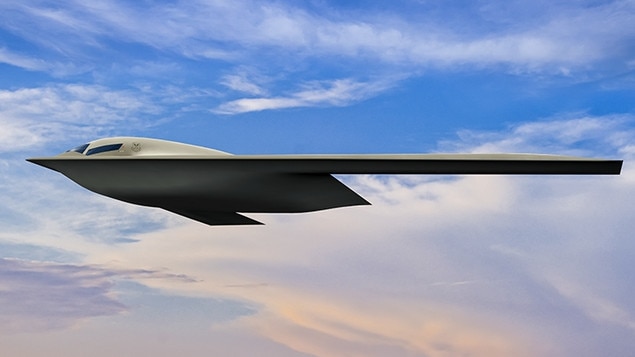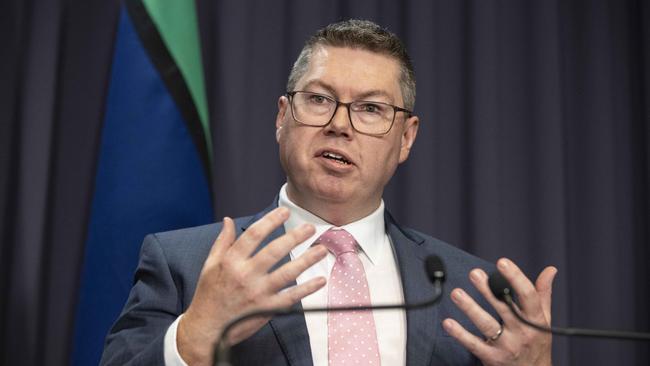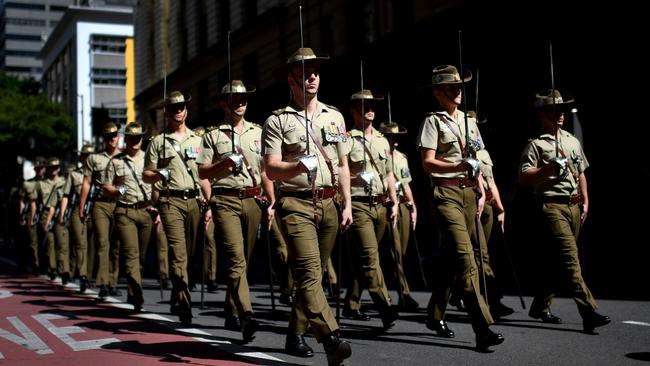Federal Budget 2022: Australia’s defence changes to boost AUKUS, guard against China
Australia’s defence force is sizing up whether to buy the world’s most feared stealth bomber after the federal budget delivered the highest defence spend in more than two decades.
Federal Budget
Don't miss out on the headlines from Federal Budget. Followed categories will be added to My News.
Exclusive: Defence is arming itself with a shopping list of potential new acquisitions including the long-range UFO-like stealth bomber the B-21 Raider with its budget expected to increase.
The Albanese Government’s first budget announced on Tuesday night flagged a lift in operational tempo for the ADF as it called for greater self reliance to deliver “deterrent effects”.
Just what that looks like is not expected to be announced before March next year when a strategic review will conclude Australia’s future needs.
But it is understood a new interim missile-armed warship and the American B-21 stealth bomber — to be formally unveiled by the US Air Force in December — were being actively reviewed.
Critically and in the wake of the war on Ukraine, Australian defence officials were looking to urgently have a greater long-range deterrent for an adversary well before they can get close to our shores.

While the Labor Government spelled out defence spending would rise to $48.7 billion this year and eventually to more than 2 per cent of GDP, that was based on inflation and the falling value of the Australian dollar.
But the next budget may need to include an actual increase in spending in the face of a deteriorating security climate.
Australian Strategic Policy Institute analyst Dr Marcus Hellyer, a former Defence Department senior official tasked with providing advice on major capital investments, said new acquisitions like a long-range bomber was a reasonable consideration.
He said with the AUKUS security pact’s central plank acquisition of a nuclear-powered submarine not likely before 2040, more immediate deterrent was required.
“The nuclear submarines is a long-range deterrent where we can reach out and impose cost and risk and uncertainty on a major power adversary at some range from Australia,” he said.
That’s the capability you want but it’s not coming until well into the 2040s so the B-21 is another way of delivering that effect at a much smaller cost much sooner.”
The batwing B-21 bomber could cost about $2 billion a piece; the RAAF has not had a long range bomber since the retirement of the F-111 in 2010.
Defence is also looking at acquiring a small fleet of the German designed K130 Braunschweig-class missile armed corvette ship to bridge a capability gap before the introduction of the delayed Hunter-class frigates.
Defence Minister Richard Marles would not comment on acquisitions before the strategic review was completed but said future purchases would require careful consideration of “every dollar”.
Dr Hellyer said there was no pool of cash sitting around and defence would have to critically think about proposed multi-billion dollar Army spend on heavy armour tanks and the need for such capability.
$270B PLAN TO GUARD AGAINST CHINA
The Albanese Government has committed to a $270 billion capability upgrade to 2030 as agreed to with the former Coalition government after its 2020 strategic review, warning of the need for self-reliance, security deterrence and engagement with the Pacific.
Overall defence spend will rise above 2 per cent of GDP — a level not seen since the late 1990s and early 2000s — to allow more fighters to take to the air and ships to sea, notably about the Pacific region.
Australia will drastically lift its military tempo in the Pacific, committing to its highest defence spend in more than two decades.
But it has flagged defence and national security spend would go 8 per cent higher in the coming year after its own updated review to be released publicly next March.
That review — to make Australia “more potent” and a capable regional security partner —
will determine new acquisitions including nuclear-powered submarines, under the AUKUS security pact as well as hypersonic missiles, advanced cyber and artificial intelligence capabilities, ground defence missile systems and drone air and sea warfare.

Meantime, the budget has allowed for a significant increase in available flying hours for all RAAF and RAN assets including Australia’s leading F-35 strike fighter.
Their operations will almost double to 12,500 flying hours in the coming 12 months while there will be more Anzac class frigates and Hobart class destroyers put to sea.
There is also an emphasis on greater aerial surveillance with the P-8A Poseidon fleet to work harder on intelligence gathering missions in the region.
The budget has spelled out the urgency in shaping Australia’s strategic direction to deter actions against national interests and respond “with credible force”.
To that end, the Albanese government has also flagged a huge emphasis on greater Pacific region.
Gone is any significant ongoing funding to the Middle East with “geographical focus priority” squarely on Pacific engagement with more than $147 million to “advance” regional security and engagement including establishing an Australia Pacific Defence School for multinational military and police training.
That initiative is in direct response to China’s push to increase its police and military presence in the region, ostensibly offering training to local forces.
The government said the Australian Federal Police will continue to deploy to Solomon Islands.

Overall $1.4 billion has been earmarked in additional development aid including $900 million for the Pacific with a new Office of Southeast Asia establish to co-ordinate whole of government efforts to deepen regional engagement.
“After nearly a decade of neglect and disrespect we are restoring our role as a diligent and dependable partner and friend to our Pacific neighbours for a stable, peaceful and more prosperous region,” Treasurer Jim Chalmers said.
He added the Australian Defence Force would have the funding it needed to also ensure it could meet all challenges into the next decade.
Defence Minister Richard Marles said all the thinking was simply about keeping Australia safe.
“The 2022-23 Budget will strengthen our regional partnerships and build our shared resilience to meet future challenges, delivering the capability needed to keep Australians safe,” Mr Marles said.

In the wake of the damaging Optus and Medibank data hacks, the cyber security fight would also be lifted by $31 million while Australia will commit $213 million over five years from 2021 toward Ukraine’s war with Russia, including $18.4 million toward more humanitarian visas for Ukrainians fleeing the fighting.
VETERANS GET A HELPING HAND
Veterans have had a huge win in their fight for compensation, with the government investing more than $230 million to recruit 500 “frontline” staff specifically to handle their health and welfare claims.
The ongoing Royal Commission into Defence and Veteran Suicide has shamed the Veterans’ Affairs administration and government into action after decades of neglect with findings that claim delays had specifically led to incidence of depression, attempted self-harm and suicide.
Treasurer Jim Chalmers said when someone signs up to the ADF they deserve to feel mentally and physically safe during and after service.
Of the huge $233.9 million committed over four years, the bulk will go toward 500 new frontline staff to speed up claims and investment in modernising DVA’s IT systems; a further $87 million over two years would go to improving pathways to access and support.

Those new hubs are to be established in northern Adelaide, Ipswich in Queensland, Hawkesbury, Queanbeyan, the Tweed/North Coast and the Hunter in NSW, one in Perth and another in Geelong in Victoria. Development of two in Queensland and Tasmania were already underway.
The government has also pledged $24 million for development of transitioning to civilian life programs and to help veterans with rising cost of living.
And a $1000 increase will be made to the annual totally and permanently incapacitated payment affecting about 27,000 veterans.
“Our veterans have protected us and in return we must look after them,” Veterans’ Affairs Minister Matt Keogh said.
“Key investments made in this Budget seek to improve the claims process for veterans,
simplify legislation and ultimately better support Defence personnel, veterans and
families as they not only need, but deserve.”
The Royal Commission in its interim report earlier this year made 13 recommendations that related to failures including unacceptable backlog of claims that in some cases ran into years and maladministration in the overall delivery of the claims system.
Rates of suicide among defence personnel past and current was higher than across the rest of the Australian population in what the commission branded “a national tragedy”.
During the previous Coalition’s regime, departmental funding was cut in real terms and only 22 per cent of disability claims were being processed within 100 days.
GOVERNMENT HACK PROTECTION
A team of cyber experts tasked with combating hack attempts on four key government departments will receive an additional $31.3 million in funding.
The Australian Taxation Office (ATO), Defence, Home Affairs and Services Australia — all of which have been subject to the relentless assaults — will benefit from an extension of a pilot program running pools of tech experts from the Australian Signals Directorate (ASD).
The ATO alone receives an incredible three million attempted hacks of its systems every month, mostly from suspected China, Russia and Iran based cyber criminals.
The monies, announced in the budget, will go toward bolstering resilience and security measures.
An additional $2 million will go toward assisting scam victims to recover their stolen identities particularly in the wake of the devastating assaults on Optus and health insurer Medibank Private.
In the latter, the medical details of 3.8 million Australians were stolen by a criminal who sold them on a Russian-language online forum.
Home Affairs Minister Clare O’Neil said it was all about responding to challenges from threats and keeping Australians safe.
The ASD had a significant $600 million boost to its operations in the previous budget which remains unchanged.
Originally published as Federal Budget 2022: Australia’s defence changes to boost AUKUS, guard against China




